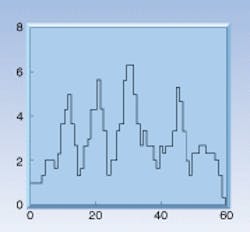X-ray interferometer may resolve black holes

Detailed resolution of black holes may be possible with an x-ray interferometry design successfully tested by scientists from the University of Colorado, Boulder, and NASA. Interferometry of x-rays has been notoriously difficult to achieve due to the extreme shortness of the waves. Vanishingly small mirror graze angles (<1 arc min) are required, resulting in an extremely inefficient collecting area. Now, advances in the sensitivity and quality of optics have enabled detection of extreme ultraviolet (EUV) and x-ray radiation at 100-milliarc sec resolution by Prof. Webster Cash and colleagues. While similar to the resolution of the Hubble Space Telescope in the optical realm, this represents a five-fold improvement over conventional x-ray telescopes, which currently achieve 500-milliarc sec resolution using highly polished mirrors.
The prototype interferometer created fringes about 0.2 mm apart, from a baseline of less than 1 mm. The design consists of two flat primary mirrors, two flat secondary mirrors, and an entrance aperture of two parallel slits. The test was performed at the 120-m-long vacuum facility at the Marshall Space Flight Center (Huntsville, AL). Compact x-ray and EUV sources were used to generate high-energy Mg Ka photons (E = 1.25 keV), which then passed through a 5-µm exit slit before entering the interferometer 16 m down the vacuum pipe. After passing through a double entrance aperture, the wavefronts reflected on the primary mirrors, which were set at 0.25° to the incoming beam. The reflected wavefronts crossed and were then directed to the secondary mirrors 17 mm away. The wavefronts emerged from the secondary mirrors very nearly parallel and traveled 100 m down the vacuum pipe to the CCD, where they were superimposed.
Each of the two beams created a vertical stripe of illumination on the CCD about a millimeter wide. When the stripes were aligned, the x-ray beams created interference fringes within the overlapping beams. The counts were then gathered into a histogram of events across the horizontal direction (see figure). A two-bin boxcar smoothing was run across the data to suppress Poisson noise. The fringe spacing of 0.2 mm is in agreement with the theoretically predicted spacing.
Sensitivity of the fringes was achieved to angular scales near 0.05 arc sec, which paves the way for applications in ultrahigh resolution. Practical ultrahigh-resolution abilities will follow by improving the optical quality of the flats from l/20 to l/100. A design reconfiguration is necessary to reduce the distance between the optics and detector. "So far we have only achieved fringe detection," says Cash, "The real goal is to create true images from the interferometric information."
Cash and his team have proposed that the next-generation x-ray interferometer use four 6-in.-long flat mirrors set at a grazing angle of 0.25°. Modeling predicts a fringe spacing of about 75 µm at an x-ray wavelength of 1 nm (1.24 keV). The new design is now under study at Goddard Space Flight Center (Greenbelt, MD) for two proposed NASA space missions. For more information, contact [email protected].
About the Author
Valerie Coffey-Rosich
Contributing Editor
Valerie Coffey-Rosich is a freelance science and technology writer and editor and a contributing editor for Laser Focus World; she previously served as an Associate Technical Editor (2000-2003) and a Senior Technical Editor (2007-2008) for Laser Focus World.
Valerie holds a BS in physics from the University of Nevada, Reno, and an MA in astronomy from Boston University. She specializes in editing and writing about optics, photonics, astronomy, and physics in academic, reference, and business-to-business publications. In addition to Laser Focus World, her work has appeared online and in print for clients such as the American Institute of Physics, American Heritage Dictionary, BioPhotonics, Encyclopedia Britannica, EuroPhotonics, the Optical Society of America, Photonics Focus, Photonics Spectra, Sky & Telescope, and many others. She is based in Palm Springs, California.
